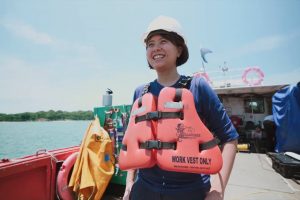All images by Wu Bingyu (@bingleswu) unless otherwise stated.
Just minutes at the Lower Peirce Trail will remind you of the ordinary magic of paying attention. When I get out of my Grab, Bing, the photographer, is crouched in the vegetation lining the trail entrance, observing something.
He points at a spot in the undergrowth. “Look,” he says. “See that snake? I think it’s a Wagler’s pit viper.” It takes me several seconds to spot the lime-green snake dozing on a branch; its head is smaller than my ear.
As we walk, however, I begin to recognise the different sounds and textures of the forest, like how the crack of a squirrel rummaging differs from the gentle crash heralding the arrival of macaques. Bing, much more attuned to the landscape than I am, points out small gems I would otherwise have missed: a spiderweb, illuminated in a shaft of sunlight; scratches on the bark of a tree which might have been made by a colugo.
There are trees enrobed in three-inch spikes and bunches of small green figs; ferns and bracken and flowers. Over the course of two visits, in addition to that Wagler’s pit viper, we see two varieties of squirrels, macaques, skinks, monitor lizards, a glimpse of a wild boar, a white-bellied sea eagle, roosters, herons, a Great Racket-tailed drongo, butterflies, spiders, mayflies, and multiple homo sapiens of all ages out enjoying the fresh air—all but a handful of the myriad species and secrets to which the forest is home.
All this reminds me that, in another universe, none of this might have existed at all. In another Singapore, we might have been standing on the manicured slopes of a golf course.


I wasn’t yet born when news of the Lower Peirce plans first appeared in the Straits Times in April 1991. Despite the innocuous headline (‘PUB developing Seletar golf course’), most of the article’s 400 words were devoted to a second, unconfirmed, golf course at Lower Peirce.
Barely anything was known about it at the time. The only information the reporter had, presumably obtained via the grapevine, was the number of holes (18), the suspected location (north of the Lower Peirce reservoir), and the appointed designers (an American company).
The PUB declined to comment. A year later, at the height of the blowback, then-Minister for National Development. S. Dhanabalan strongly implied the plans had been leaked.
“No announcement was made by my Ministry or the Planning Department,” he said, “but somehow the subject emerged in the media and of course nature lovers jumped on it and blew it up into a big matter.”
We might never know exactly how the plans came to light, or which intrepid civil servant managed to spill the beans without getting whacked by the Official Secrets Act. Despite Dhanabalan’s irritation, the ‘big matter’ would gradually fade from mainstream memory, kept out of the sanitised contents of most history textbooks.
It is also, however, a story of how those pesky nature lovers pulled off one of the most successful fightback campaigns in local conservation lore. It is a story about pissed-off officials, the perks of having friends in high places, and how the levers of power are pressed and pulled behind the scenes.
Above all, it is about how luck, timing, and a little shrewd maneuvering can sometimes end up making history—in other words, like much of history itself.
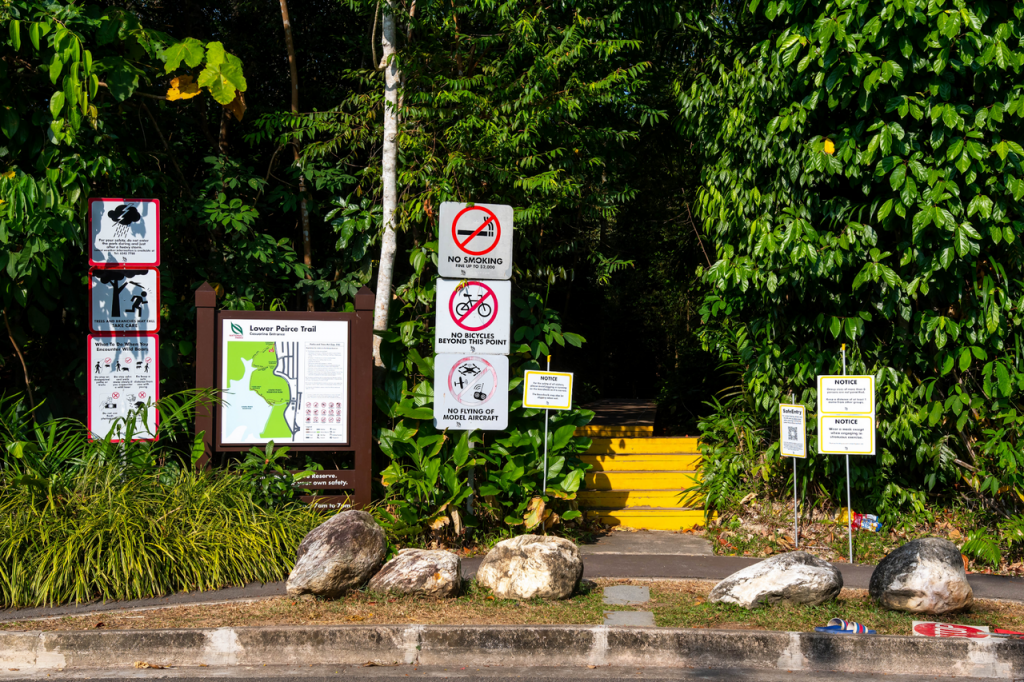
The Activists
For just over a year following that first article, nothing happened—at least, on the outside. Behind the scenes, however, the Nature Society of Singapore (NSS) had already begun lobbying the authorities to drop the plan.
The NSS was then in its infancy, having recently split from the Malayan Nature Society to avoid accusations of—ahem—‘foreign influence’. The fledgling team was a motley crew of academics, white-collar professionals, students, expats, and hobbyists, bound by a shared love of nature. Its first office was a single room in the basement carpark of the condo where its Honorary Secretary, Evelyn Lim, lived.
According to Professor Wee Yeow Chin, a retired NUS academic who was the then-President of the NSS, the group had mostly focused on public education rather than conservation campaigns. Its record with the latter was mixed: they had lost several of the battles they had fought, including pushing to preserve Serangoon Estuary and the Senoko area (now the Sembawang HDB estate). “We were total amateurs,” he told me.
Their first notable success came in 1986, when one of their members, Richard Hale, stumbled upon a marsh engulfed with migratory birds while out wandering in Kranji. He and five other NSS members swung into action, preparing a report on the area’s wildlife which they sent to every MP.
But Hale, in addition to being an avid birdwatcher, had another feather in his cap: he happened to be the CEO of HSBC (Singapore). In addition to the report, he embarked on a charm offensive, bringing former President Wee Kim Wee and other high-ups to the site. Their efforts paid off, leading to the Sungei Buloh Nature Reserve being established in 1990.
Naturally, when word of the Lower Peirce plans reached the NSS, they were outraged.
According to Richard Corlett, a scholar of East Asian ecology, around 90% of Singapore was covered in primary forest when the British arrived in the early 1800s. Gambier and pepper plantations had decimated most of this by the end of the century. By the 1990s, all that was left after further clearance from World War II, development, and other urbanisation was around 200 hectares, or 1% of the original.
Meanwhile, mature secondary forest like the kind at Lower Peirce—woodland which has regenerated for at least 70 to 80 years after being cleared—came up to around 1000 hectares. At around 120 hectares, the area for the proposed golf course amounted to more than 10% of this. Moreover, the land on which it sat was legally protected, having been gazetted as a nature reserve under the National Parks Act of 1990.
On top of that, the forest is home to at least 900 species of flowering plants, 100 ferns, and 250 animals. Of these, some are incredibly rare or endangered, like the Raffles Banded Langur, of which only 40—60 are estimated to exist in Singapore today. These, amongst other treasures, were what the NSS feared would disappear.

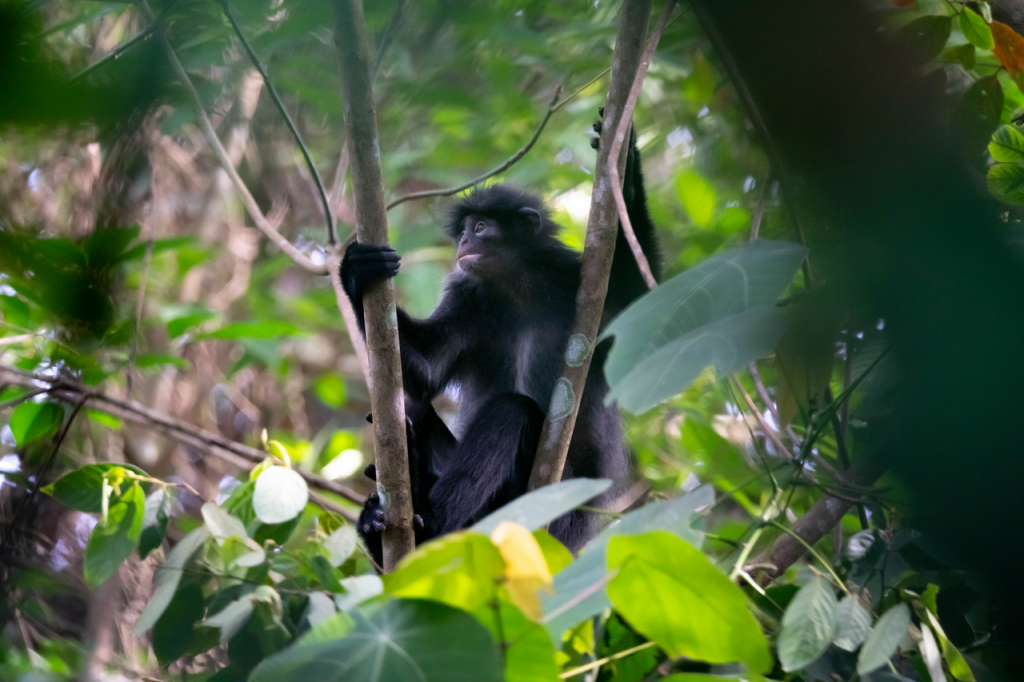
The People
Unlike the Sungei Buloh lobby—which was, essentially, an Inception-style feat of nudging the government into adopting a cause as their own—the NSS did not have the advantage of time. The government was playing White, and it had already made the first move. Saving Lower Peirce meant stopping wheels which were already in motion.
According to Maria Francesch-Huidobro, author of Governance, Politics, and the Environment: A Singapore Study, the NSS sent a letter to Minister Dhanabalan in July 1991 informing him of their concerns. He replied in January 1992 to suggest that they hold their horses, as the PUB had already commissioned an Environmental Impact Assessment (EIA) and no decision would be made till this was completed.
This was not enough to reassure the NSS, who decided to go public in March 1992. According to Prof. Wee, Dominic Nathan, a reporter on ST’s environment beat and now a senior editor at the newspaper, jumped at the chance to break the story. “And we were eager for coverage, of course,” he added.

A follow-up article appeared in the Sunday Times on 10 May, announcing that in addition to their own EIA, the NSS would be launching a public petition.
Finding out who instigated the petition proved tricky. Prof. Wee, to my incredulity, claimed he had no idea there was even a plan to collect signatures till he read it in the newspaper (this allegation was also rebutted by the NSS in an earlier statement). Other NSS members I spoke to could not remember, the meetings in question having taken place almost 30 years ago.
Eventually, when I managed to track down Evelyn—the NSS’ Honorary Secretary, and, as its only full-time staff member back then, responsible for all its administrative work—she claimed the idea came from her.
“The NSS was not very big at the time, so I thought it would be good if we tried to set up a petition,” she told me. “Maybe it would give us more of a fighting chance.”
In any case, the four former NSS members I spoke to all agreed that how the petition gained ground was a largely informal process, fuelled by persistence, indignation, and good old word-of-mouth.
According to Andrew Tay, a former volunteer, members basically brought the petition with them wherever they went. This included official NSS outreach events, such as at malls or the Substation (RIP), but also anywhere they might find a sympathetic ear on the fly.
He recalled taking copies to a cafe he frequented at Orchard Point (now closed), where he ran into actors Edmund Chen and Xiang Yun. Both signed it happily. “I can’t really recall anyone being very against signing,” he said.
Another former senior NSS member, who declined to be named for this story, talked about bringing it with him to cocktail parties. “I’d take a couple of sheets with me and go, would you like to sign this. And people would say, oh yes, that’s a good idea, give me some blank ones. And it snowballed from there.”
Support came from some unexpected places too. On a whim, Evelyn decided to try and track down former Deputy Prime Minister S. Rajaratnam, who had recently retired from political office.
“I knew he lived nearby me, so I thought, why don’t I go walk around and see if he would sign. I found him in his home in Chancery Lane. He was sitting in his garden, reading the paper,” she recalled. Although he was a bit nonplussed, once she explained what she was after, “he signed, no questions asked.”
Eventually, after several months of canvassing, the petition gathered around 17,000 signatures. The NSS grew so worried that the authorities might confiscate it that they had the physical copies transferred to a bank vault for safekeeping.
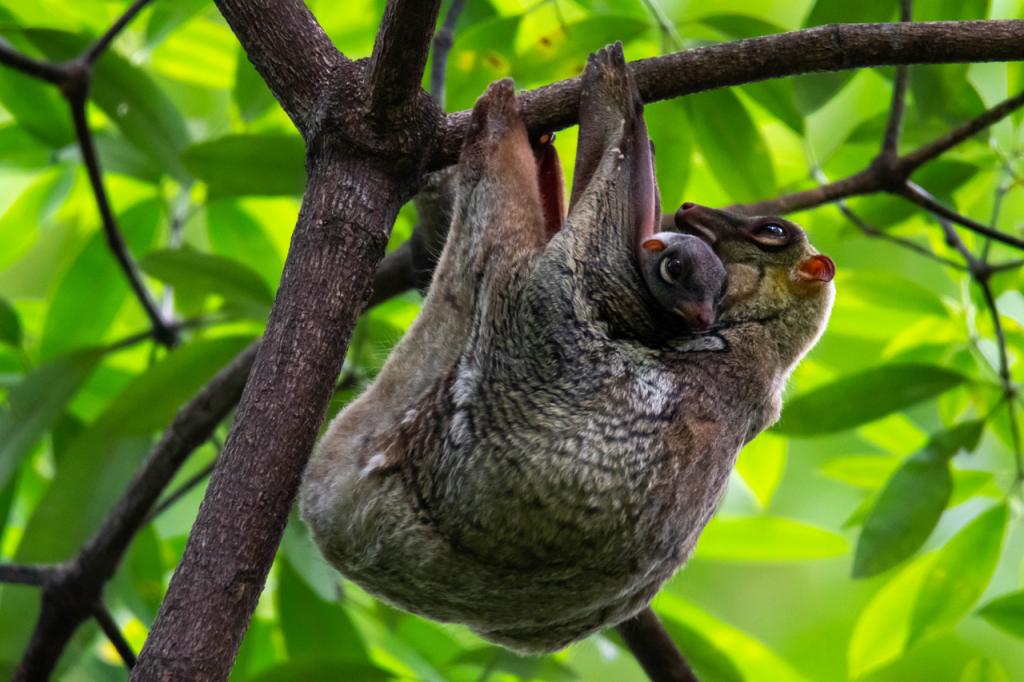
17,000 signatures is a remarkable feat for several reasons, not just because social media was but a then-distant figment of Mark Zuckerberg’s imagination, and every single one had to be painstakingly gathered in person.
First, local interest in green issues was minimal, and country club membership was one of the infamous 5Cs which defined middle-class aspirations of the era. Moreover, it was the early 1990s, a period when most people would sooner relinquish their CPF funds than talk politics—let alone give off a whiff of dissent—in public. Civil society was still reeling from the Operation Spectrum crackdown of 1987, and reluctant to put a toe out of line.
Amidst this climate, thousands of people signed a petition which asked for not only their names, but IC numbers, addresses, and occupations as well. Signatories included not only the wealthy and well-connected, but civil servants and police officers.
“In Singapore terms, this was unbelievable,” recalled the anonymous former NSS member. “What I really remember from this is the extraordinary willingness of people to help … it was absolutely astonishing, because it showed that we, as ordinary people, could do something.”
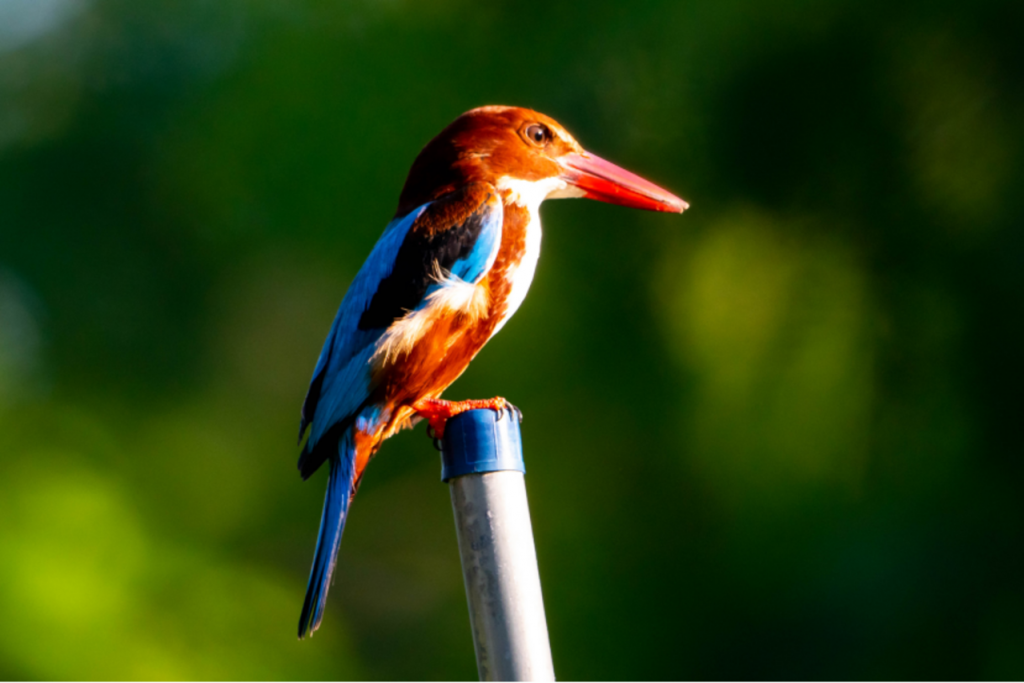
The Politicians
All this while, unhappiness over the golf course was steadily building.
By early May, the first of several indignant Forum letters began appearing in the Straits Times. (“Which is more critical? Golf or water?” raged the writer of one). In early June, the then-President of the Singapore Institute of Landscape Architects, Tay Bee Choo, wrote a sternly-worded missive condemning the plans.
“Any incompatible encroachment into our nature reserves threatens the existing fragile equilibrium of life within it. We should not view the nature reserves as a land bank for future development, but rather as a permanent natural asset,” she wrote.
The uncharacteristic display of public anger was enough to put the government on the defence. Ms. Tay’s letter was followed by a terse reply from the URA, reminding everyone that a decision had not yet been made.
Minister Dhanabalan, speaking to the press the day after, emphasised this. “If it [the PUB’s EIA] shows that great ecological damage will be done, then we will not approve it,” he said.
Nonetheless, apparently unable to resist throwing some shade, he added, “We are as well aware as anybody else that a golf course is not a nature reserve, so there’s no need for anybody to get particularly concerned … [I]f they [the nature-lovers] become unrealistic, they will lose credibility.”

By early August, he was singing quite a different tune.
With the public still spooked, Dhanabalan moved into damage-control mode, reminding everyone that the golf course was merely “an idea”. Echoing his words from several weeks back, he insisted, “I would like to assure the House that my ministry is as aware as anyone else of the need to protect our nature reserves.”
Going by this, I can only assume the good Minister must have been seriously annoyed when then-Deputy PM Lee waded into the fray a few days later. Although he acknowledged that other sites could be used for the golf course, “Singaporeans obviously enjoy playing golf,” he opined. “An extra golf-course would be something which they would appreciate.”
“If you need it urgently and indeed there is pressure for it, well, if it makes sense, we have to do it. We should not get emotional and agitated about environmental issues.” (Just imagine the memes this would have spawned had social media been around in 1992.)
At this stage, NParks appeared to be curiously silent, a point which had also been raised by Ms. Tay in her June Forum letter. Rather confusingly, although the Central Catchment area, as a nature reserve, fell under NParks’ jurisdiction, Lower Peirce—as a reservoir—did not.
Francesch-Huidobro notes that the statutory board was then very new, having only been established by merging several government departments in 1991, and was mainly advisory and regulatory in nature. At least one former NSS member I spoke to speculated that while they might have been privately supportive, as a government body, they were unable to break rank in public—something we’ll come back to later.


The Publications
To be sure, not all public sentiment was vehemently anti-golf-course. A searing op-ed appeared in the ST just before National Day, titled, “Go green, but don’t confuse hard choices with polemical hysteria”.
The writer, while arguing for a more measured cost-benefit approach to environmental issues, couldn’t resist invoking the ‘Western culture’ straw man so favoured in the 1990s (and, it must be regretfully noted, still alive in 2021).
“As Singaporeans, like New York yuppies, become more comfortable, such issues are likely to creep up in their agenda … In fact, asinine polemics advanced by some Western environmentalists are beginning to find their way here,” he wrote.
Nonetheless, the saga continued to receive coverage in the mainstream press. In what reads like a prelude to the current furore over Dover Forest/Kranji/Seletar, some of this focused on the lack of mandatory EIAs.
Cherian George, long before his promotion to favourite target of Fabrications Against the PAP, was then a journalist covering the saga at the Straits Times. He added his own two cents on the matter in a commentary for the newspaper, arguing that EIAs should not be regarded as weapons meant to obstruct the development process.
“They are simply decision-making tools that include environmental concerns into the development process,” he wrote.
The PUB-commissioned EIA had been completed in May 1992. Although its full contents were not made public, the report found that the landscape would not be unduly damaged if the course layout were changed. In response, the PUB amended its proposal to a 27-hole course, rather than 36. Meanwhile, the NSS had been working on its own EIA for several months.
The final document—you can find a digitised version online today—ran to around 80 pages, including annexes. Its contents include a comprehensive breakdown of the types of wildlife in the affected area, as well as a list of arguments against the golf course. These ranged from legal (the protection afforded by the National Parks Act), environmental (the potential loss to science and biodiversity, as well as threats like water pollution), social and economic (the disappearance of a potential environment ‘classroom’ and recreation area), political (how could a supposedly-First World country do such a thing?!) and, finally, moral.
The golf course “would be a blot on Singapore’s image as a civilised nation and responsible world citizen,” it states. Its Executive Summary concludes, in forbidding all-caps: “CLEARANCE OF THIS FOREST MEANS THAT A PROMISE TO THE PEOPLE OF SINGAPORE, AND TO THE WORLD COMMUNITY, HAS BEEN BROKEN.”

Even with this fire-and-brimstone warning, it is hard to imagine these arguments persuading the government to back down. One report does not the sacred cow of Economic Development slay—let alone one which almost didn’t become public.
Two things are instructive to consider at this stage. One, of course, is the sizable amount of public ire which the saga had already generated. The government’s PR headache would become a full-blown migraine if the golf course went ahead.
The other is that the NSS’ Patron and author of its EIA’s foreword, as well as the Chairman of the Main Committee of the 1992 UN Conference on Environment and Development, was Professor Tommy Koh.
According to Prof. Wee, the groundwork for the NSS EIA was done in teams. The Society’s ‘birdies’ did one section, the botanists did another, he compiled everything, and the final document was handed off to Prof. Koh to write the introduction.
Here, the plot thickens.
According to correspondence obtained by Francesch-Huidobro, in early September 1992, Prof. Wee wrote to Prof. Koh to inform him that the NSS’ EIA was complete. However, he wanted some advice: NParks—who, it appears, were not absent from the fray after all—had requested that they not share the EIA with the PUB and the media.
Their reason? The PUB’s EIA was being reviewed by the government, and NParks was privately lobbying for the proposal to be dropped, relying on material from the NSS’ EIA to make their case. According to NParks, it would be easier for the PUB to back down if opposition came from another government ministry rather than from an NGO. (Scholar Tan Tay Keong notes that in addition to NParks, URA, MND, and MTI also raised early objections to the course proposal internally.)
In other words, if the NSS stayed quiet, it might give the PUB a chance to change course while saving face. Prof. Wee, on the other hand, worried that if the NSS did not seize the moment, they would be too late.
Prof. Koh apparently agreed that the PUB’s face was more worth sacrificing than 40,000 trees. In a move that would have made Cersei Lannister proud, he faxed a reply to Prof. Wee the same day, instructing him to send the EIA “to all MPs and NMPs, Editors of all newspapers, and all Members of the National Council.”
I couldn’t find a clear announcement in the papers indicating that the plan had been scrapped, nor could the NSS members I spoke to recall seeing one; perhaps the authorities had concluded that it might be more prudent to let the plan go quietly than admit defeat in public.
In any case, by late 1992, the lack of word seemed clear: the proposal was almost certainly dead in the water.
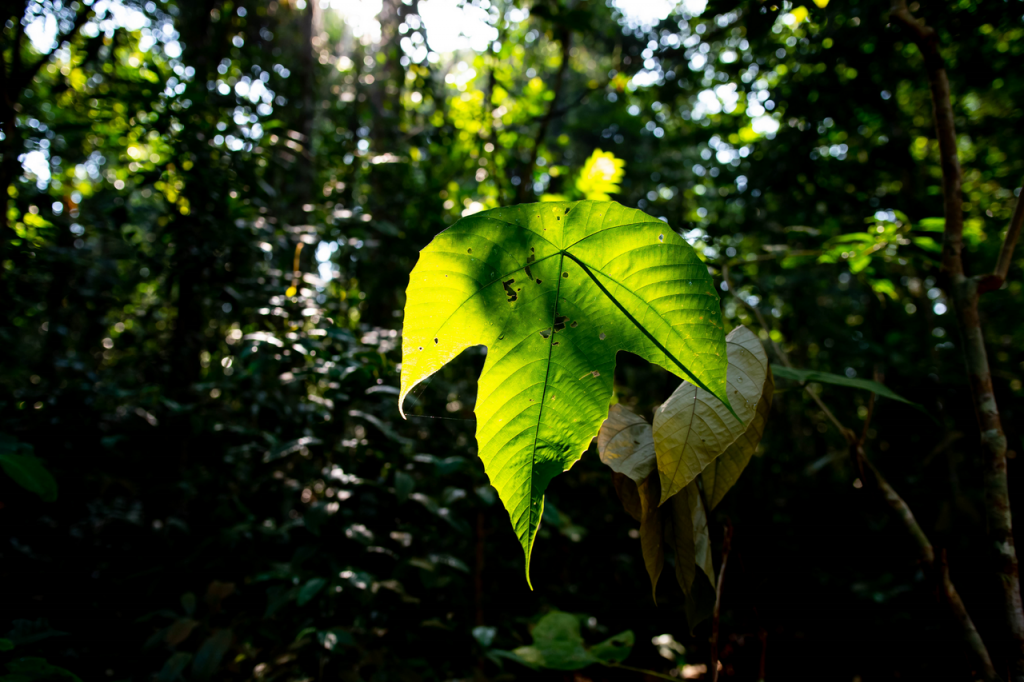
The Aftermath
“We were happy, of course,” said Prof. Wee, “but life goes on.”
The battle for Lower Peirce had been won; the forest had been saved. The full consequences of that victory, however, would take many years to be felt. First was the personal fallout for Prof. Wee, who received a friendly visit from two officers from the Internal Security Department at his office at NUS.
“They asked, “What is your purpose with all this protesting? I said, we’re just interested in nature,” he recalled.
“One talked, one listened. That was their style. I offered to send them copies of our newsletter and they were like, no, no need.” (To his knowledge, none of the other NSS members received a similar visit.)
Although he walked out of that meeting without a stay-home notice in Changi, he believes he was subtly made persona non grata for the rest of his academic career.
“I don’t regret it,” he says of the confrontation with the government, “but in hindsight you can’t progress because you get blacklisted in a very subtle way. For example, they might second me to the Dean’s Office or whatever, but not touch me for administration.”
“When you do such things, you don’t think,” he said. “You just go ahead as if it is the most natural thing. Something is happening, you need to protect the forest. But there were a lot of things I didn’t know.”
Unfortunately, his relationship with the NSS would turn out to be another casualty. However strong the group’s shared love of nature, it did not extend to a similar unity in terms of methods, and fissures which appeared during the Lower Peirce saga eventually widened into chasms.
Relations between Prof. Wee, Hale, and other members who had been involved in the Lower Peirce saga (including the late Subaraj Rajathurai), and other factions in the NSS subsequently became badly strained, ending with the former group eventually distancing themselves from the Society.

Some of these differences in opinion became evident when I asked Prof. Wee what he made of the outcry over the mistakenly-cleared forest in Kranji. The news had begun blowing up on social media only the day before our interview.
To my surprise, he was dismissive.
“Maybe they’ll hang me for saying this, but I don’t think it’s that big a deal,” he said. “A mistake was made. So what. You leave any patch of land to grow over for 10, 20 years”—he gestured to his garden—“eventually you get a forest again.”
To him, what people should be more concerned about is protecting the patches of primary and mature secondary forest which still exist today—ie. making sure that the Central Catchment, Bukit Timah, and other nature reserves are never expropriated.
“I think most people … when they see vegetation, they see forest as a whole,” he says, a hint of bitterness entering his expression. His quavery 84-year-old voice hardens noticeably for the first time in our conversation. “They don’t know what stage, what composition it’s at. The trees change. A hundred years it’s like this, another hundred years, it will be different again.”
Although he shared Prof. Wee’s concern about protecting existing nature reserves, Dr. Ho Hua Chew, the current Vice-President of the NSS, stressed that even less mature secondary forests help sustain biodiversity by providing extra home and foraging ground for wildlife. As space in the existing reserves is limited, animals may leave to seek food or shelter in less crowded forests.
The Kranji woodland area, he noted, had provided harbour for migratory birds and housed around four nesting eagle sites, all of which were overwhelmed by development projects. And given the rampant pace of such development, although secondary forest can regrow within decades, it is not clear that replacement patches will get the chance to spring up.
Meanwhile, Evelyn and the anonymous former NSS member were more measured in their assessments. The latter argued that preserving less mature green areas, even if relatively uninteresting, was important to reduce pressure on more popular reserves like Bukit Timah. Too many visitors, he said, could end up damaging the landscape.
“For Kranji … I think we can let it go,” mused Evelyn. “They admitted a mistake and they said they will look into it. But to prevent future mistakes like this, we must tighten loopholes and make sure there are proper procedures.”


Epilogue
Was the Lower Peirce saga a one-time outlier that could never occur again today, or does history repeat itself, and reveal us to be making the same mistakes?
I found myself returning to this question time and again as I researched this story. Certainly there were aspects that were unique: the outrageously favourable optics, which brought a touch of class warfare to a conservation battle; the early leak of the plans, the absence of social media, and the extent to which power players worked behind the scenes. (PM Lee, to his credit, has since gotten much better at PR management.)
And yet, some things remain unchanged.
30 years on, mandatory EIA legislation has not been introduced (although the Government announced in 2019 that, absent security concerns, their contents would be made public). Although the framework was significantly enhanced last year, with further refinements to come, it does not include aspects mandated by other jurisdictions, like public inspection, or independent auditing.
More significantly, amongst the general public, it is not evident that the balance between economic growth and environmental protection has tipped in favour of the latter.
It is unclear, for example, whether the NSS’ petition would have garnered as many signatures had the proposal been for more HDB blocks rather than a golf course. And despite the keen interest in the future of Dover Forest, recall the debates over the Cross-Island Line which ran for most of the 2010s. Although an outcome which would cause the least possible amount of damage was sought, that the Line got the green light at all shows that nature reserve status—recalling the NSS EIA’s all-caps warning—is no absolute guarantee of protection.
And as evidenced by our increasing run-ins with wild boars and macaques, we are still figuring out how to live with, and amongst, nature.
“People don’t really like nature,” remarked Prof. Wee. “They like to look, but not go in. It is the in thing now, to say I am pro-nature and conservation, but it is another question to live with it.”
The anonymous NSS member was more foreboding. “Sometimes, even with the best of intentions, we get things wrong,” he mused.
“We interfere with nature at our own peril, because you don’t know what the effect is going to be. Everything is interconnected.”

Although the original golf course never materialised, it is with no small amount of irony that I note that, today, one end of the Lower Peirce area opens out onto another golf course. The end of the trail closest to Lower Peirce Park overlooks the edge of a course belonging to the Singapore Island Country Club.
I hadn’t realised this before this story, and as Bing and I reach the end of the boardwalk, I stop to gaze at it, startled and bemused. The contrast between the banks is striking: one is completely untamed, the other dotted with buggies trundling away in the morning sun. The discovery rattles me. Had we averted disaster, only to end at the same finish line?
At that moment, from across the water, right where the ill-fated course would have been, comes the cackle of a kingfisher. Mother Nature, it seems, finds ways of having the last laugh.
Sources
Corlett, Richard T. (1992). The Ecological Transformation of Singapore, 1819-1990. Journal of Biogeography, 19(4), 411-420.
Francesch-Huidrobro, Maria. (2008). Governance, Politics, and the Environment: A Singapore Study. ISEAS Press.
Tan, Tay Keong. (2001). IPS Working Paper No. 9: Social Capital and State-Civil Society Relations in Singapore.



